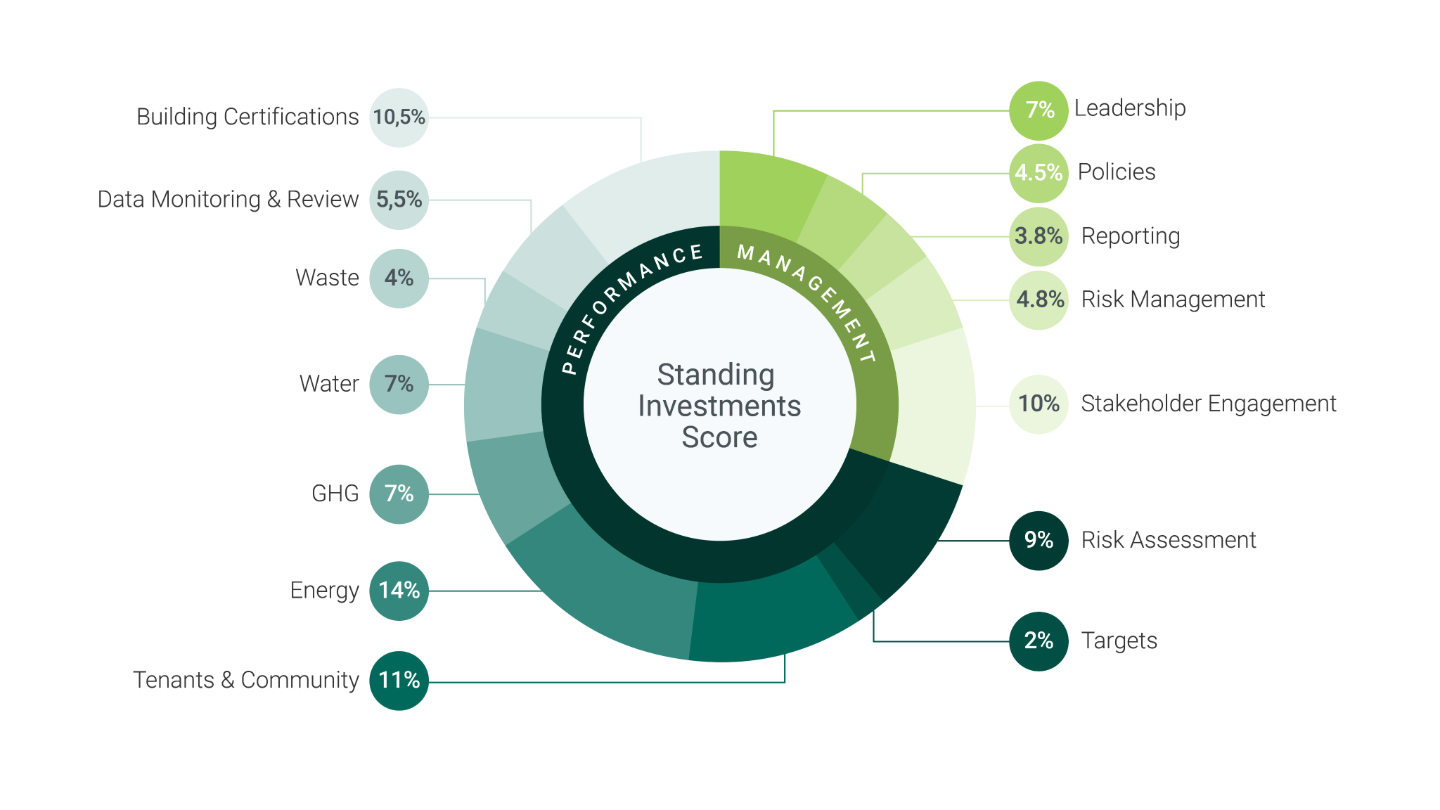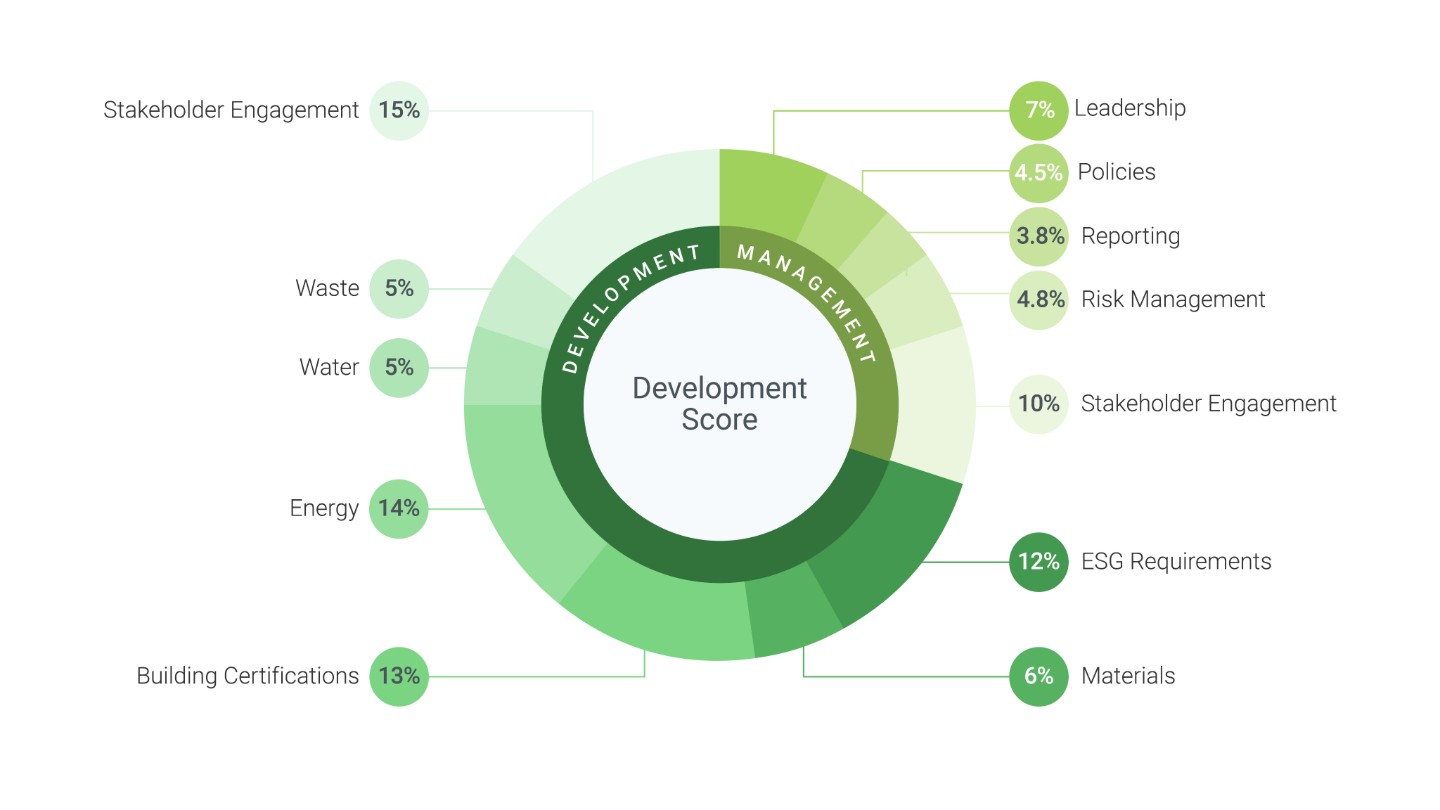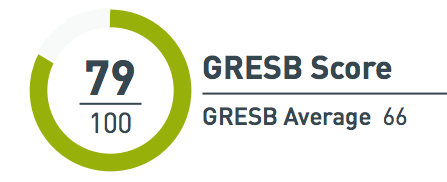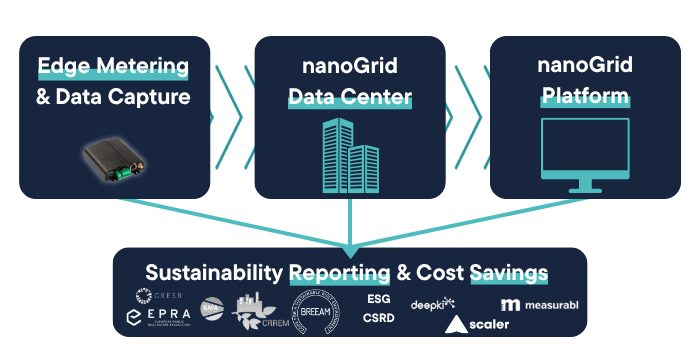For today’s real estate owners and managers, ESG isn’t a nice-to-have, it’s a must-do. Investors are demanding it. Regulations like CSRD are enforcing it, tenants are expecting it.
But here’s the catch: sustainability data in commercial real estate is fragmented. Energy use sits in one system, waste metrics in another, and half of other metrics still lives in tons of different spreadsheets. To measure and compare ESG performance in real estate, GRESB is a go-to framework.
GRESB (the Global Real Estate Sustainability Benchmark) has emerged as the global standard for measuring ESG performance in real estate and infrastructure portfolios. It gives investment managers, fund operators, and asset owners a clear benchmark to assess where they stand, and how they compare, in the context of sustainability.
nanoGrid is an official GRESB partner, we make managing and reporting effortless, by sumbitting your utility data for GRESB in just a few clicks.
In this article, we’ll walk you through what GRESB is, how it works, and what real estate owners can do to make it work for them. Especially when utility data plays a starring role.
What Is GRESB? And Why Was It Created?
GRESB stands for the Global Real Estate Sustainability Benchmark. It was introduced in 2009, by a group of leading pension funds who wanted better insights into the ESG performance of their real estate investments. These insights focus key environmental, social, and governance (ESG) criteria that are critical for sustainable investment.
At that time, there was no standard. Every asset manager had their own way of interpreting it, their own excel files, and their own ideas of what “sustainability” exactly was, impossible to compare.
GRESB changed this.
Introducing a globally recognized framework to assess, score, and benchmark the ESG performance of real estate portfolios and infrastructure assets. In 2024, over 2,200 real estate participants submitted data through the GRESB assessment (source: 2024 GRESB results).
So, what exactly is a GRESB assessment?
In a nutshell: GRESB collects validated ESG data, through a structured survey, analyses it via an automated scoring model (0–100) split into Management and Performance components and generates a single GRESB score.
The data collected through this process is critical for creating industry benchmarks and evaluating individual asset performance. This GRESB score reflects their overall ESG performance. Which enables investors to compare sustainability performance across regions, sectors, and fund types using standardized metrics.
As a result, GRESB reporting has become a key part of how financial market evaluate risk, resilience, and long-term value in the real estate sector.
But GRESB isn’t just for investors.
More and more property owners and sustainability managers use it internally too. As a tool to identify areas for improvement, structure their ESG data collection, and back up their claims with a globally trusted benchmark.
Want a quick GRESB win?
Read 8 practical tips to boost your GRESB score in our clear, concise guide. Your roadmap to higher ratings and stronger ESG performance.
How GRESB Works: A Deeper Look at the GRESB Assessment Process
Now that we’ve covered the “why” behind GRESB, let’s look at how it works.
GRESB Real Estate Assessment Components
It’s structured into three key components, each focusing on different aspects of sustainability in real estate:
1. The Management component
This section evaluates how your organization integrates ESG into its decision-making. It looks at policies, leadership structures, risk management, and disclosure practices. Think of it as the strategy layer: how well ESG is governed at the organizational level.
2. The Performance component
This is where things get more granular. It focuses on asset- and portfolio-level data: covering key performance indicators (energy use, GHG emissions, water, waste management) for companies or funds with operational buildings.
3. The Development component
This component evaluates how your company addresses ESG factors during the design, construction, and renovation of buildings. It focuses on the integration of sustainability into new projects and major upgrades, ensuring long-term climate resilience and alignment with global standards.
These three components form the foundation of two GRESB benchmark types.
Check information: It produces two benchmarks, which consider the assets’ management and performance indicators. These are the GRESB real estate benchmark (for operational buildings) and the GRESB development benchmark (for buildings in planning or construction). Each participant receives a score, which can be compared with peers.

Source: GRESB
Standing Investments Benchmarks Score vs. Development Benchmark Score
Participants with operational (standing) assets complete the Management + Performance Components, resulting in a Standing Investments Benchmark score. Those involved in development projects complete the Management + Development Components, earning a GRESB Development Benchmark score.
The GRESB development benchmark score is specifically designed to evaluate the ESG efforts during various phases of development projects.

source: GRESB
Process of a GRESB Assessment
Here’s how the GRESB process works, from submitting your data to receiving your final score and benchmark results.
1. Submission
Each year, between April 1 and July, real estate companies and funds upload their ESG data through GRESB’s online portal during a fixed reporting window. Once the deadline passes, GRESB begins its evaluation.
2. Validation
A robust, three-layer validation process checks the accuracy and consistency of submitted data. This includes reviewing evidence and flagging inconsistencies, ensuring results are credible before the scoring begins.
3. Scoring
After the validation, an objective scoring model automatically calculates scores for each component of the assessment (management, performance, development) without manual intervention.
4. Benchmarking & Results
Each entity’s performance is then benchmarked against its peers, taking into account factors like property type, geography, and entity type (listed or private).
Afterwards, participants receive both an absolute GRESB Score and a relative GRESB Rating (1–5 stars). The rating reflects how your performance stacks up against peers, with 5 stars reserved for the top 20%. All results are delivered via detailed benchmark reports and comparison tools.
GRESB Scores and GRESB Ratings: What they mean (and don’t mean)
Once your GRESB assessment is submitted through GRESB’s online portal. You will receive two main outputs:
- A GRESB score (0 to 100).
- A GRESB rating: 1 to 5 stars.
But what do those ratings and scores mean, and just as importantly, what don’t they tell you?
Let’s break it down.

GRESB score example (source: GRESB).
What is the GRESB score?
The GRESB Score is a comprehensive measure of ESG performance, expressed as a percentage (with 100 being the maximum). It offers quantitative insight into how your ESG efforts perform, in absolute terms, over time, and compared to your peers.
Each question in the GRESB assessment carries a specific point value, covering a broad range of ESG topic. From energy use and emissions to water, waste, and stakeholder engagement. The stronger and better-documented your ESG practices and asset-level data, the higher your score.
Achieving a high GRESB score, or showing consistent year-over-year improvement, can boost a company’s market visibility and reputation as a sustainability leader. It gives you an advantage in the market while building credibility with “key” stakeholders.
But here’s what it doesn’t mean
It doesn’t automatically guarantee low emissions, or that your buildings are fully decarbonized. GRESB is a reporting benchmark, not a certification of carbon neutrality.
GRESB Rating: How You Stack Up
The GRESB Rating gives real estate owners and managers a clear picture of how their sustainability performance compares to others worldwide. It’s based on your GRESB Score and how it ranks within five performance tiers, or quintiles, across all companies that took part in the GRESB Assessment.
If your score places you in the top 20% of all participants, you’ll earn a GRESB 5 Star Rating. This is the highest recognition for sustainability leadership. On the other hand, being in the bottom 20% means a GRESB 1 Star Rating.
Because this rating is updated every year and benchmarked globally, it helps you understand exactly where you stand in the market.
GRESB Alone Isn’t Enough, But It’s the Starting Point
GRESB scores are powerful, but they’re just one piece of your overall ESG picture. You might score well on governance and reporting but still face issues with building performance or tenant engagement.
In fact, some investors now use GRESB alongside other frameworks like CRREM to understand carbon risk and long-term decarbonization potential. Especially for older or utility-heavy real estate portfolios.
In other words: GRESB doesn’t just score. It guides. And that’s exactly why more and more real estate investors, asset managers, and sustainability teams are making it part of their long-term strategy.

Who uses GRESB ?
GRESB isn’t just another ESG hype or ESG buzzword. It has become a trusted signal in global real estate. GRESB data is used for making informed real estate investment decisions in financial market. Used by a wide network of various stakeholders across the entire investment chain.
Now let’s take a closer look:
For fund managers and institutional investors
More than 150 institutional investors, representing over $50 trillion in assets, use GRESB data to evaluate ESG performance and guide their investment strategies (source: GRESB).
Why? Because GRESB offers standardized, validated data that helps them:
- Compare sustainability performance across funds and regions
- Identify climate-related risks in infrastructure or real estate assets
- Align portfolios with global benchmarks like the Paris Climate Agreement
- Monitor ESG progress over time with clear scoring and benchmarking
For fund managers, a strong GRESB rating more than just a badge, it’s a credibility tool that supports fundraising and long-term reputation.
For asset managers and operators
In practice, GRESB helps asset managers and property companies to:
- Benchmark their ESG performance against peers
- Detect blind spots in operational practices or data coverage
- Prioritize upgrades and retrofits that move the needle
- Back up ESG disclosure with concrete, traceable data
For real estate companies and developers
As mentioned before, GRESB features a dedicated development Benchmark designed specifically for real estate development projects. The real estate development benchmark is designed to evaluate the ESG performance of new construction projects and significant renovations.
This benchmark enables property developers to track ESG performance throughout the design and construction phases of properties, ensuring alignment with long-term sustainability goals. Therefore, for listed property companies and Real Estate Investment Trusts (REITs), GRESB reporting is especially valuable. In helping meet investor demands for ESG transparency and staying competitive in a market where sustainability is no longer optional.
Why GRESB is your ESG signal to the market
Whether you’re managing a logistics portfolio, developing commercial properties, or steering a multi-billion-euro investment fund. Your GRESB participation signals to the market that you’re taking ESG seriously.
In a world of greenwashing and vague claims, GRESB brings measurability, comparability, and accountability to real estate ESG.
It doesn’t just help you report better.
It helps you operate smarter, plan strategically, and build trust with stakeholders — from tenants to investors.
GRESB and Utility Data: Why Traceability is Non-Negotiable
GRESB assessments don’t just reward ambition, they reward accuracy. That’s why traceable utility data is quickly becoming a big lever for improving your score.
Mainly because energy consumption really influences the performance component within the GRESB assessment on different levels.
Energy consumption and greenhouse gas emissions (Scope 1 and Scope 2) are central to the Performance Component of the GRESB Real Estate Assessment. These metrics are heavily weighted, not only because they reflect environmental performance, but also because they can be measured, verified, and benchmarked across portfolios.
But there’s a catch. GRESB doesn’t just look at reported totals. It asks:
- Where does your data come from?
- How much of it is validated?
- Can you track it back to specific buildings, assets, or meters?
- Does it reflect real, operational performance?
Without detailed, granular, and verifiable data, you’re left submitting estimates, and estimates don’t score well.
The Data Challenge for Real Estate Owners
Many CRE owners still rely on utility bills, spreadsheets, or BMS (Building Management System) exports. The result? Gaps in coverage, delayed insights, and a lack of traceability.
Worse, when tenant consumption isn’t submetered or when utility providers are slow to share data, your reporting coverage drops, and so does your GRESB score.
This is where traceable utility data becomes essential. Not just for reporting, but for audit readiness and credibility. Accurate reporting characteristics are crucial for audit readiness and credibility.
Why nanoGrid Bridges that Gap
At nanoGrid, we understand the pressure real estate owners face to deliver validated ESG data, especially for assessment and reporting frameworks like GRESB, BREEAM, CSRD, LEED, etc. That’s why we go straight to the source, making sure the data is both granular and traceable.

How?
- At nanoGrid, we install our own on-site hardware to ensure real-time, reliable utilities data.
- Monitoring across all meter types (any meter, any manufacturer, old or new, sealed or not) and countries on one platform
- All data flows into our secured cloud and user-friendly SaaS solution, giving you one clear view of consumption across all sites.
- Whether you’re reporting to GRESB, CRREM, BREEAM, or EPRA. We ensure your data is integration-ready-streamlined for third-party ESG tools and built for compliance and insight.
- We achieve 17.5+ GRESB points for clients such as Westbridge, CBRE & Goodman through seamless (sub)metering of water, district heating, gas & electricity
Ready to go deeper?
Real-time utility monitoring is only one piece of the puzzle. If you want to drive measurable ESG progress and cut energy waste across your entire portfolio, explore these next reads:
- Utility Data Management: Turning Meter Data Into Actionable ESG Insights. Learn why a centralized utility-data strategy is the backbone of credible carbon reporting and cost control.
- Submetering: see how tenant-level meters make energy consumption visible, verifiable, and easier to improve.
Conclusion: Real sustainability performance starts with data you can trust
GRESB isn’t just about ticking all the boxes. It’s about proving your sustainability performance with standardized and validated data. And confidently showcasing it to the market.
In a landscape where ESG transparency defines investor confidence and compliance, real estate owners can’t effort fragmented reporting. What matters now is accuracy, coverage, and clarity
GRESB helps you do more than just comply. It helps you compete. It turns disconnected sustainability efforts into a clear, comparable, and credible benchmark that investors understand and stakeholders’ trust. It highlights strengths, exposes blind spots, and brings structure to what can often feel like an overwhelming ESG landscape. And as your score improves, so does your market positioning and fund visibility.
Whether you’re just starting your ESG journey or aiming to move from 3 to 5 stars, GRESB gives you the framework, feedback, and focus to improve year after year.
Because in today’s market, real estate sustainability isn’t a statement, it’s a signal. And GRESB makes sure the right people are paying attention.
Keep in mind, companies like we, nanoGrid, make this possible. By (sub)metering utilities like water, gas, district heating, and electricity. We’ve helped clients gain over 17.5 GRESB points while significantly improving their energy efficiency overall.
Next step toward a higher GRESB score
Ready to discover the impact nanoGrid can have on your portfolio? Contact us for a personal walkthrough of our technology and processes, and start accelerating your journey to better GRESB results and accurate utility data.





